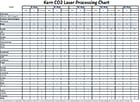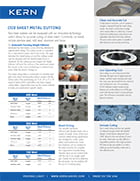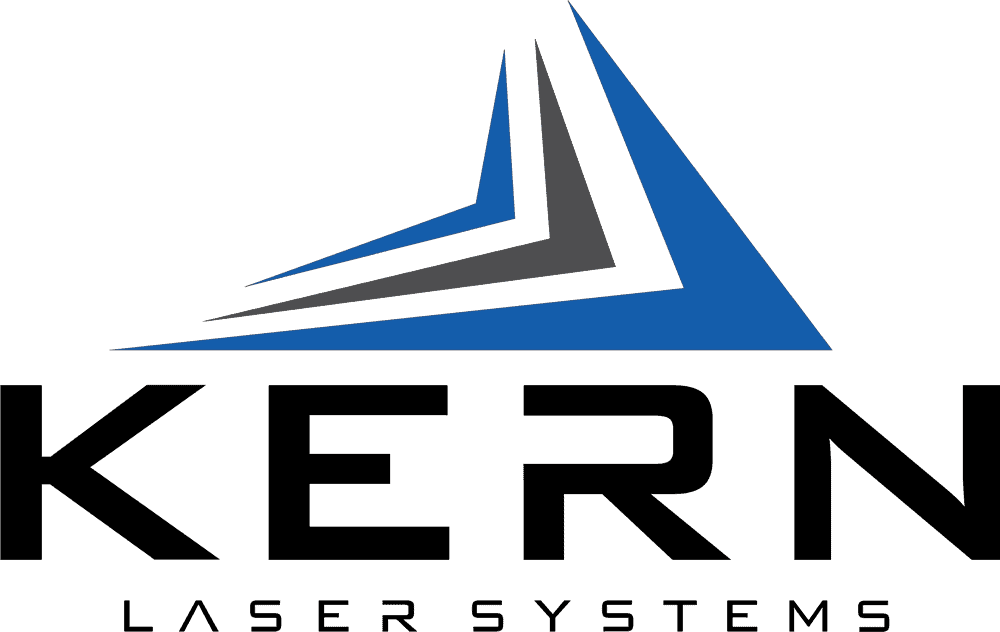Laser Resources
Top 10 FAQ
Laser safety should be a top priority for any organization. Kern manufactures Class 2 and Class 4 laser systems. Both are very safe when operated properly and when required safety protocols are followed. It is important to know the laser classification of your machine and implement a proper safety program.
Kern’s LaserCELL and FiberCELL models fall under our Class 2 models as they feature an enclosure. These lasers do not require the use of safety glasses under normal operating conditions.
The OptiFlex, OptiDual, EcoFlex and Micro models are classified as Class 4 laser ystems. These four models fall under this classification because of their open format design. All personnel working on or around the laser system are required to wear properly rated laser safety glasses.
The other important protocol to follow is developing and implementing a successful laser safety program. This includes assigning a Laser Safety Officer (LSO). Laser Safety Officer training classes are available from The Laser Institute (LIA.org).
All of Kern’s laser systems are CDRH compliant and feature safety protocols such as emergency stop switches, proper labeling, a sealed beam delivery, 5-second key switch, indicator light and interlocked access points.
For additional information on laser safety please visit our Laser Safety page.
Our knowledgeable staff is happy to assist you and your team with any laser safety related questions.
Yes, Kern has teamed up with Geneva Capital to offer financing options on our laser cutting and laser engraving systems. Geneva Capital makes it easy to get the equipment you need, while experiencing the benefits and tax savings of leasing.
Please visit our Equipment Financing page for more information.
Yes, from time to time we have used trade-ins, trade show models, and demo systems that we sell at a discounted price. We refurbish these machines to like new conditions and typically back them up with a 1 year warranty. Contact a sales associate today and ask for a list of used machines in stock.
The laser systems electrical panel will require a service to power various components of the machine. Please talk to your salesman to determine the proper electrical requirements for your machine configuration.
A closed-loop chilling unit will require distilled water and a cleaning solution to keep the water lines clean. We include enough cleaning solution for the initial 6 months of the laser systems life.
One of several assist gas will be required depending on the material you want to process. Compressed air, oxygen and nitrogen are a few commonly used gases. A low pressure purge gas may also be needed for some of the higher wattage lasers. Gas consumption charts are available for your review.
The laser tube itself is also considered a consumable. The unit will need to be recharged with gas after a certain amount of years. Kern has developed a quick replacement strategy so your machine will be up and running as quickly as possible.
The optics of the laser system include lenses and mirrors. With proper maintenance these optics can last years. However, it is a good idea to keep spare in stock in case one needs to be replaced. Kern’s beam path is sealed which greatly decreases the amount of smoke, dust and debris that comes in contact with the optics. Positive air pressure is also hooked up to the nozzle. This makes it difficult for smoke and debris to come in contact with the focusing lens.
Other consumable parts are bellows, nozzles, cutting beds and ceramic isolators.
It is a common misconception that aluminum is easier to cut than steel. Yes, aluminum is softer and has a lower melting point but these two properties don’t play as big of a role as the reflectiveness of the metal. The reflective nature of aluminum requires a higher peak power to penetrate through the material. A 500W and 650W lasers will cut up to approximately .048″ and .063″ aluminum, respectively.
The process is very simple.
First, the S-FOCUS lens assembly needs to be removed and replaced with the V-FOCUS lens assembly. A quick alignment test through the nozzle is also a good idea.
If you are cutting a thick metal that requires a higher laser power it is recommended that you replace the honeycomb table with the durable steel grid work included with the metal cutting package.
The complete process will only take about 2-3 minutes.
A typical OptiFlex laser system that is operating at full capacity will consume around 12,100 watts or 12.1kW/hr. If your electric company charges $0.075kW/hr, the machine will cost about $0.91 per hour. Of course there are other consumables to consider such as cutting gases, distilled water, optics, etc. That being said, the costs involved in running our laser systems vary between each customer’s application. We suggest you contact a sales associate for a comprehensive overview of such costs.
Maintenance on our laser systems can be completed in as little as 10 minutes per week. A daily, weekly and monthly schedule will be highlighted in the laser system manual. Common maintenance procedures include replacing chiller fluids, greasing bearings, oiling rails, cleaning optics and cleaning filters.
This one’s easy! Our machines are 100% designed and manufactured in Minnesota, USA.
Many materials are suitable for laser cutting and engraving. Some of the most popular that we see are acrylic, stainless steel, wood, foam, textiles, aluminum, mild steel, granite, marble, glass and so on. We invite you to send us your materials to be laser processed. Once we process them we will return them so that you can see the results with your own eyes. Please visit our Applications & Materials page for a more comprehensive list of materials that can be cut and engraved.
Product Brochures

OptiFlex
View OptiFlex Brochure
Click Here
LaserCELL
View LaserCELL Brochure
Click Here
Laser Processing Chart
View Laser Processing Chart
Click Here
MICRO
View Micro Brochure
Click Here
FiberCELL
View FiberCELL Brochure
Click Here
Laser Processing Chart - Metric
View Metric Laser Processing Chart
Click Here
Kern Lasers Brochure
View Kern Lasers Brochure
Click Here
EcoFlex
View EcoFlex Brochure
Click HereFiber Laser Processing Chart
View Fiber Laser Processing Chart
Click Here
OptiDual
View OptiDual Brochure
Click Here
